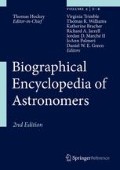Born Woodplumpton, Lancashire, England, 3 September 1837
Died Edinburgh, Scotland, 27 October 1905
Ralph Copeland served as Scotland’s Astronomer Royal in Edinburgh.
Copeland’s early education was completed at a grammar school in Kirkham, England. In 1853, he journeyed to Australia and spent the next 5 years in the colony of Victoria, working on a sheep ranch but also trying his hand at digging for gold in the Omeo district. Copeland’s interest in astronomy arose during this period, and his desire to pursue an astronomical career led him back to his homeland. But Copeland was denied admission to Cambridge University. In turn, he apprenticed himself to a Manchester firm of locomotive engineers. Several coworkers assisted him in establishing a private observatory. Copeland married a first cousin, Susannah Milner, in 1859. She died, however, during the birth of their second child in 1866.
Copeland again determined to follow an astronomical career, and was admitted to Göttingen University in 1865. He gained practical experience at the university’s observatory, under the direction of Ernst Klinkerfues . Copeland participated in the observation and reduction of stellar positions in two zones of declination between −2° and the Celestial Equator. These results, published as the Göttingen Star Catalogue (1869), were unsurpassed before 1900. During this period, Copeland assisted a German geodetical survey along the coast of Greenland and was awarded his Ph.D. in 1869 for a study of the orbital motion of the southern binary star, α Centauri.
After returning from Greenland, Copeland was appointed assistant astronomer (1871–1874) at the observatory of William Parsons , the Third Earl of Rosse, in Parsonstown, Ireland. In collaboration with the Fourth Earl, Copeland investigated the Moon’s radiant heat. He was remarried to Theodora Benfrey of Göttingen; four more children were born to the couple. Copeland held a brief post at the Dunsink Observatory (Dublin, Ireland), observing reddish dwarf stars, before being appointed director of the Dunecht Observatory in Scotland (1876–1889), succeeding David Gill . There, Copeland observed comets and published their orbital elements in the observatory’s Circulars. He observed the transits of Venus in 1874 (Mauritius) and 1882 (Jamaica). For 3 years (1881–1884), he coedited the journal, Copernicus.
Copeland’s interests were certainly eclectic, and reflected many developments that arose across the span of his career. While trained in the traditional methods of positional astronomy, he readily pursued astrophysics and successfully made the transition from “old” to “new” astronomies, which few of his contemporaries accomplished. Copeland conducted important spectroscopic observations of comets as well as novae, emission nebulae, and Wolf-Rayet stars. He was among the first astronomers to exploit the astronomical seeing conditions found at high altitudes within the Andes Mountains of South America. Copeland’s successful expedition was later instrumental in establishment of the Harvard College Observatory’s field station at Arequipa, Peru. He was elected a fellow of the Royal Astronomical Society in 1874.
Upon the resignation of Charles Smyth , Copeland was appointed Astronomer Royal for Scotland in 1889 and concurrently Regius Professor of Astronomy at Edinburgh University. Copeland’s principal task, however, concerned the selection of a new observatory site at Blackford Hill, and supervision of its construction. That institution was opened in 1896, but by then, Copeland’s advancing age and declining health had begun to take their toll. Although he traveled abroad to observe three total solar eclipses (Norway, 1896; India, 1898; and Spain, 1900), the bulk of his astronomical work lay behind him. Copeland suffered an attack of influenza in 1901, from which he never fully recovered. His observations of Nova Persei (1901) were the last that he issued among the Edinburgh Observatory Circulars. He succumbed to heart disease.
Selected References
Brück, Hermann A. (1983). The Story of Astronomy in Edinburgh from Its Beginnings until 1975. Edinburgh: Edinburgh University Press, esp. pp. 44–65.
Dreyer, J. L. E. (1906). “Ralph Copeland.” Monthly Notices of the Royal Astronomical Society 66: 164–174.
Author information
Authors and Affiliations
Corresponding author
Editor information
Editors and Affiliations
Rights and permissions
Copyright information
© 2014 Springer Science+Business Media New York
About this entry
Cite this entry
Marché, J.D. (2014). Copeland, Ralph. In: Hockey, T., et al. Biographical Encyclopedia of Astronomers. Springer, New York, NY. https://doi.org/10.1007/978-1-4419-9917-7_302
Download citation
DOI: https://doi.org/10.1007/978-1-4419-9917-7_302
Published:
Publisher Name: Springer, New York, NY
Print ISBN: 978-1-4419-9916-0
Online ISBN: 978-1-4419-9917-7
eBook Packages: Physics and AstronomyReference Module Physical and Materials ScienceReference Module Chemistry, Materials and Physics

